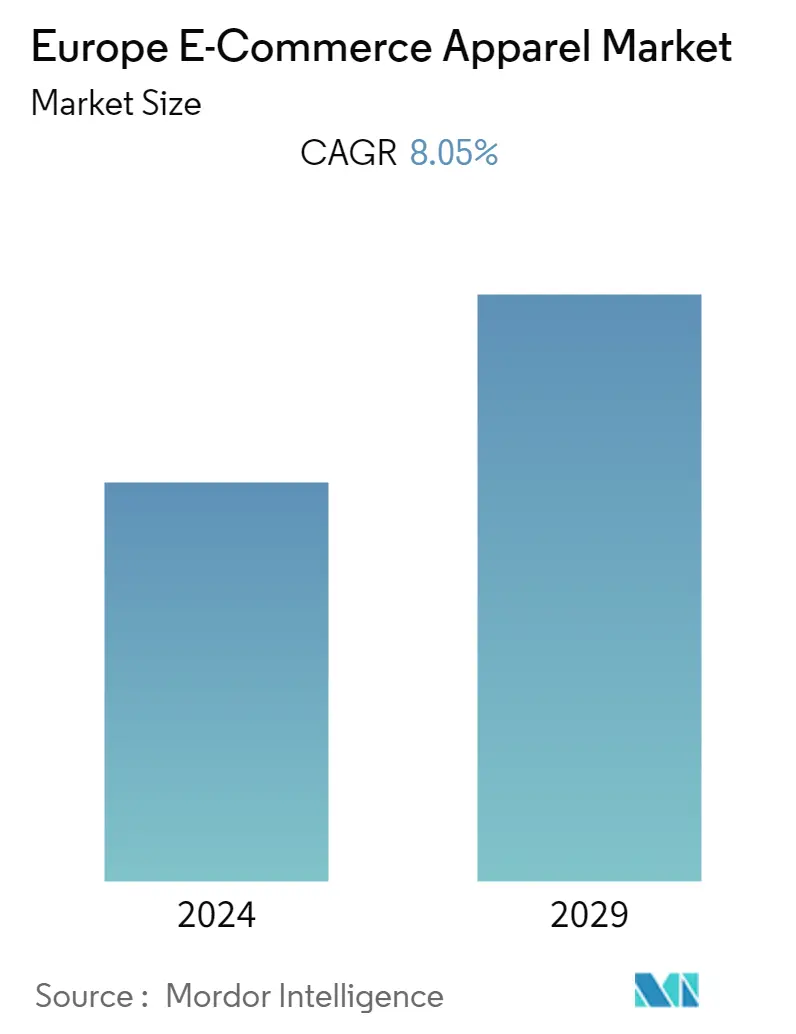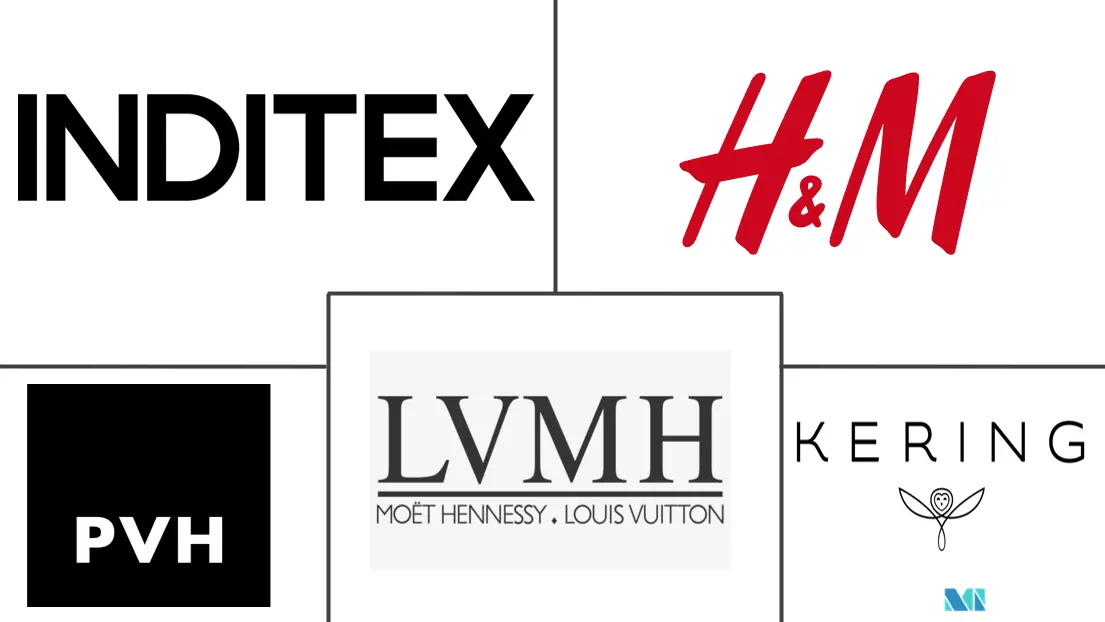Market Size of Europe E-Commerce Apparel Industry

| Study Period | 2019 - 2029 |
| Base Year For Estimation | 2023 |
| Forecast Data Period | 2024 - 2029 |
| Historical Data Period | 2019 - 2022 |
| CAGR | 8.05 % |
| Market Concentration | Low |
Major Players
*Disclaimer: Major Players sorted in no particular order |
Europe E-Commerce Apparel Market Analysis
The Europe e-commerce apparel market was valued at USD 86.11 billion for the current year and is projected to register a CAGR of 8.05% over the next five years.
- The e-commerce apparel industry is undergoing major transformations as a result of growing globalization, technological innovation, and changes in consumer buying patterns. The growing apparel industry and the influence of fashion trends are the major factors driving e-commerce sales in the apparel industry as it provides the customer with the opportunity to try and explore different designs and fits such as regular fit, slim fit, and loose fit trails while staying at home.
- Additionally, as customers are researching more about sustainable fashion options, the continuous innovation in fabric and growing consumers trend towards sustainable fashion have propelled demand, owing to the benefits, it provides to buyers and sellers. Thus, e-commerce has flourished and gained significant relevance among retailers and consumers. While customers research this segment, based on keyword searches, the companies market and suggest their products on the websites, therefore gaining customer attention.
- For instance, in October 2022, Gonser Group announced its plans to develop Mimikry, a new jeans productive technique that is much more sustainable and cost-reducing than traditional methods, with the same final effect. Further, to meet the needs of millennial consumers, fashion eCommerce is continuously evolving. For example, fashion e-commerce is currently experimenting with new technologies such as social commerce, metaverse, non-fungible tokens (NFTs), Web 3.0, and virtual reality to promote its acceptance in both the real world and the virtual one. This is done to find new ways to capture the interest of Gen-Z consumers.
- Moreover, significant strides have been made in the fashion industry, demonstrating how novel and innovative methods for consumers to interact with online stores are strongly favorable to the future of e-commerce retail. Thus, the upcoming market opportunities in the e-commerce apparel market include Virtual reality (VR), augmented reality (AR), and artificial intelligence (AI) that help transform the customer experience. For instance, in August 2022, German luxury fashion house Hugo Boss announced its plans to launch a virtual try-on service in partnership with Reactive Reality, a leading 3D digitization technology company. The company claims that the partnership enables customers in Germany, the United Kingdom, and France to use body measurement-based shopping through these personalized avatars.
- Furthermore, an increasing number of United Kingdom-based fast fashion companies (including Next, Boohoo, and Zara) began charging customers a modest fee to return purchases. This fashion retail practice is likely to catch on as companies attempt to decrease waste and promote sustainability commitments and as tighter margins make unlimited free returns less practical. This trend may encourage budget-conscious shoppers to make in-person purchases so that they can try before they buy. Such instances could restrain the e-commerce apparel market.
Europe E-Commerce Apparel Industry Segmentation
E-commerce apparel includes the buying and selling of fashion and apparel products online, specifically through e-commerce platforms.
The Europe e-commerce apparel market is segmented by product type, end-user, platform type, and geography. Based on product type, the market is segmented into formal wear, casual wear, sportswear, nightwear, and other types. Based on end users, the market is segmented into men, women, and kids/children. Based on platform type, the market is segmented into third-party retailers and the company's own website. The study also analyzes major geography, such as Germany, the United Kingdom, France, Italy, Spain, Russia, and Rest of Europe.
The market sizing has been done in value terms in USD for all the abovementioned segments.
Europe E-Commerce Apparel Market Size Summary
The Europe e-commerce apparel market is experiencing significant growth, driven by factors such as globalization, technological advancements, and evolving consumer purchasing behaviors. The convenience of online shopping, coupled with the ability to explore various fashion trends and sustainable options, has made e-commerce a preferred choice for many consumers. Innovations in technology, such as virtual reality, augmented reality, and artificial intelligence, are enhancing the online shopping experience, making it more interactive and personalized. The market is also witnessing the integration of social commerce and digital currencies like NFTs, which are appealing to younger consumers, particularly Gen-Z. However, the trend of charging for returns by fast fashion companies in the UK may influence consumer behavior, potentially encouraging more in-person shopping.
The United Kingdom holds a prominent position in the European e-commerce apparel market, benefiting from a well-established online shopping culture and a strong omnichannel strategy among retailers. Companies are merging online and offline platforms to provide a seamless shopping experience, which includes options like click-and-collect services. Major players in the market, such as Inditex, Hennes & Mauritz, and LVMH, are focusing on product innovation and sustainability to maintain their competitive edge. The market's competitive landscape is characterized by the presence of both regional and multinational companies, all striving to enhance their market share through strategic partnerships, mergers, and the introduction of unique product offerings.
Europe E-Commerce Apparel Market Size - Table of Contents
-
1. MARKET DYNAMICS
-
1.1 Market Drivers
-
1.1.1 Online Retailers Offering Seamless Shopping Experience
-
1.1.2 Growing Consumer Inclination Towards Latest Sustainable Fashion
-
-
1.2 Market Restraints
-
1.2.1 Limited Sensory Experience
-
-
1.3 Porter's Five Forces Analysis
-
1.3.1 Bargaining Power of Suppliers
-
1.3.2 Bargaining Power of Buyers/Consumers
-
1.3.3 Threat of New Entrants
-
1.3.4 Threat of Substitute Products
-
1.3.5 Intensity of Competitive Rivalry
-
-
-
2. MARKET SEGMENTATION
-
2.1 Product Type
-
2.1.1 Formal Wear
-
2.1.2 Casual Wear
-
2.1.3 Sportswear
-
2.1.4 Nightwear
-
2.1.5 Other Types
-
-
2.2 End User
-
2.2.1 Men
-
2.2.2 Women
-
2.2.3 Kids/Children
-
-
2.3 Platform Type
-
2.3.1 Third Party Retailer
-
2.3.2 Company's Own Website
-
-
2.4 Geography
-
2.4.1 Germany
-
2.4.2 United Kingdom
-
2.4.3 France
-
2.4.4 Italy
-
2.4.5 Spain
-
2.4.6 Russia
-
2.4.7 Rest of Europe
-
-
Europe E-Commerce Apparel Market Size FAQs
What is the current Europe E-Commerce Apparel Market size?
The Europe E-Commerce Apparel Market is projected to register a CAGR of 8.05% during the forecast period (2024-2029)
Who are the key players in Europe E-Commerce Apparel Market?
Inditex, Hennes & Mauritz, PVH Corp, LVMH and Kering SA are the major companies operating in the Europe E-Commerce Apparel Market.

